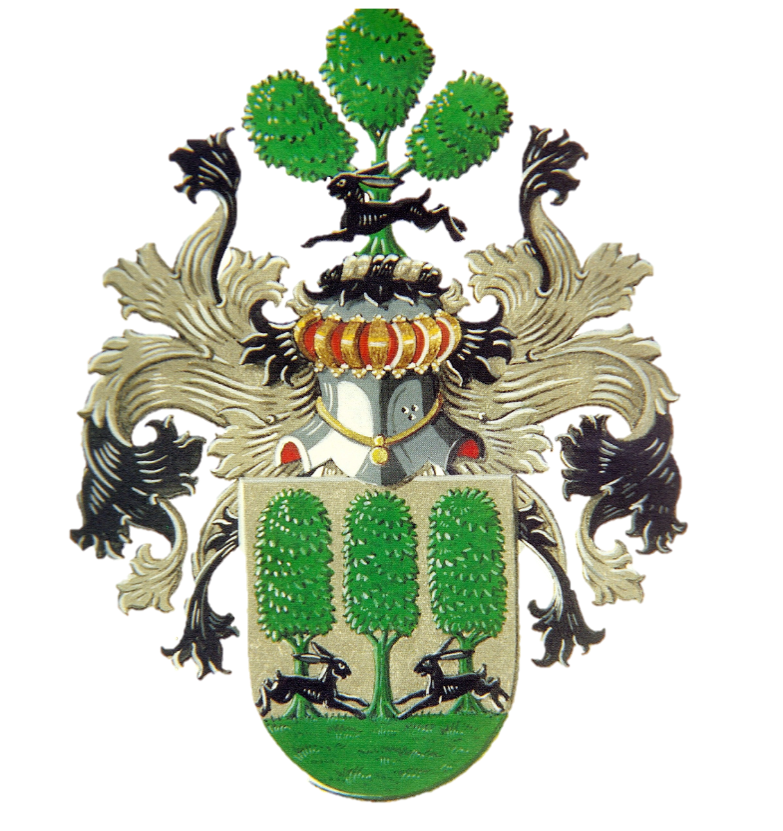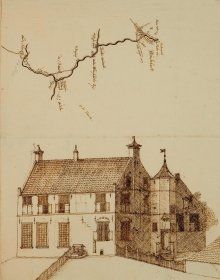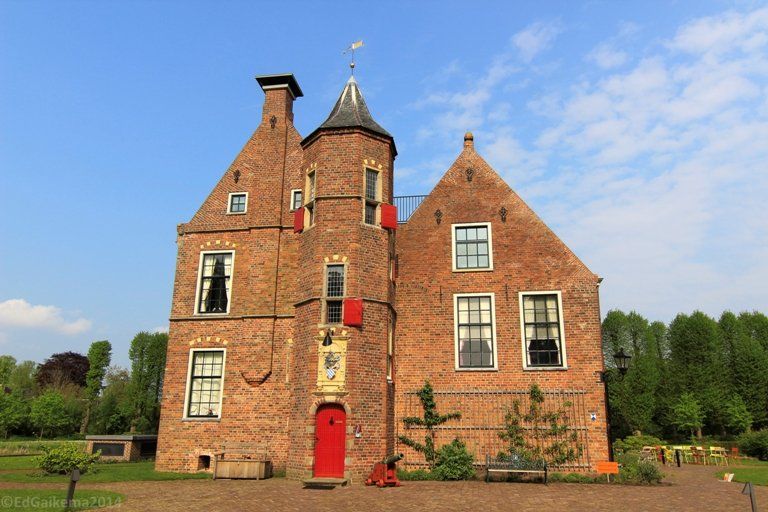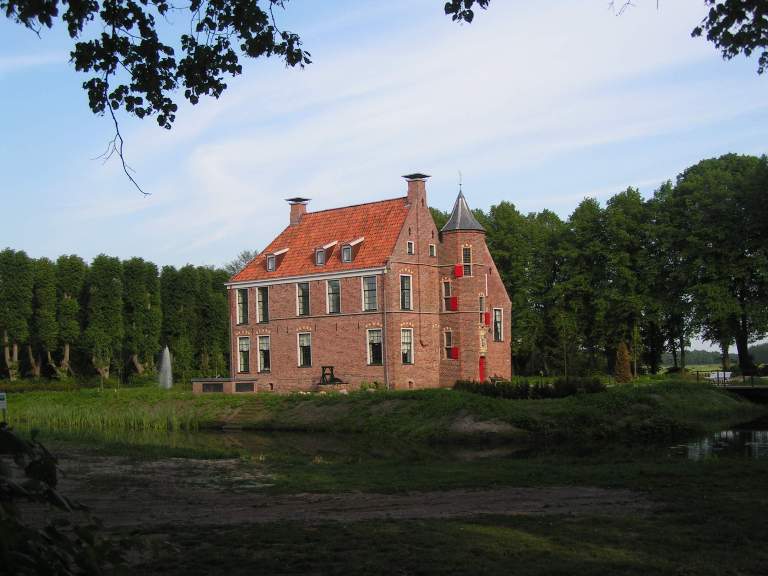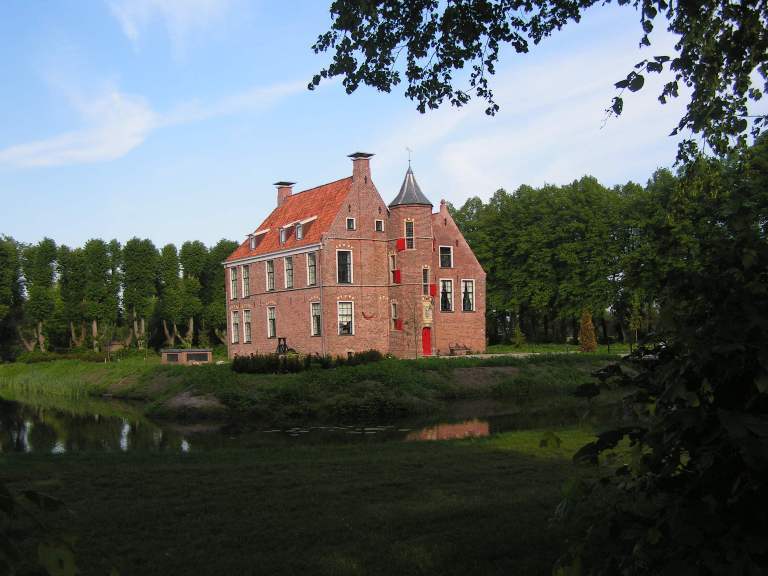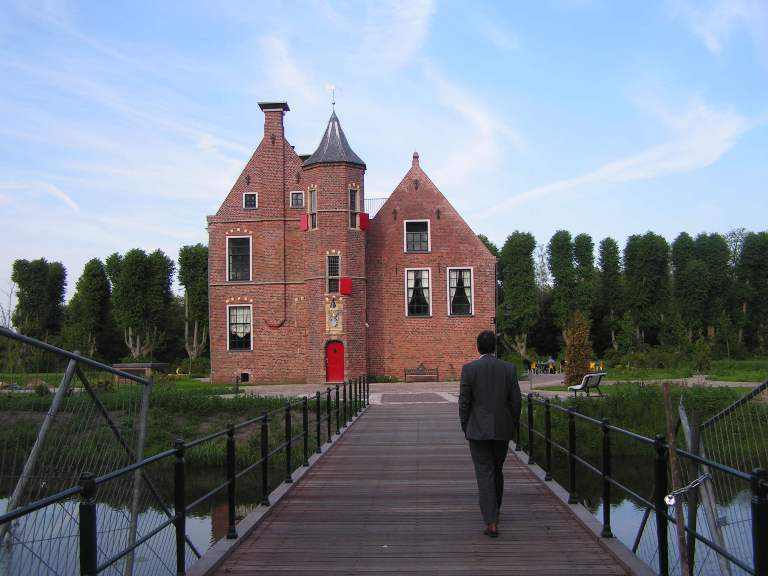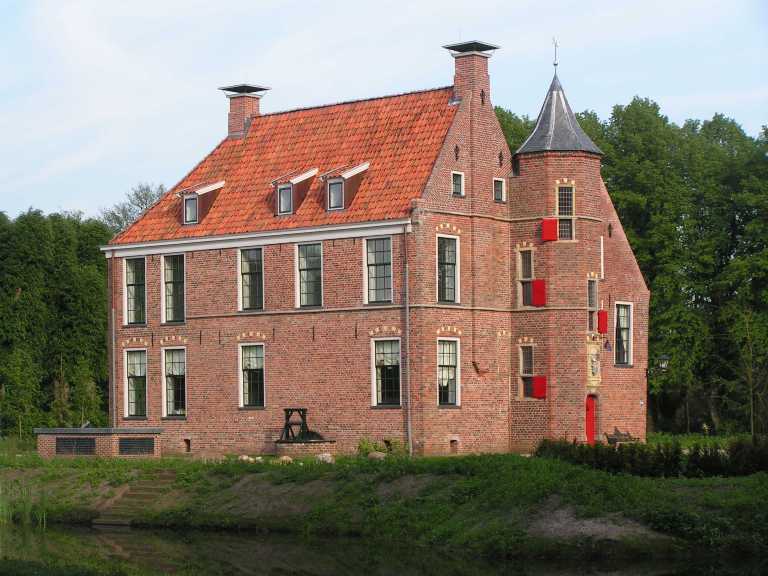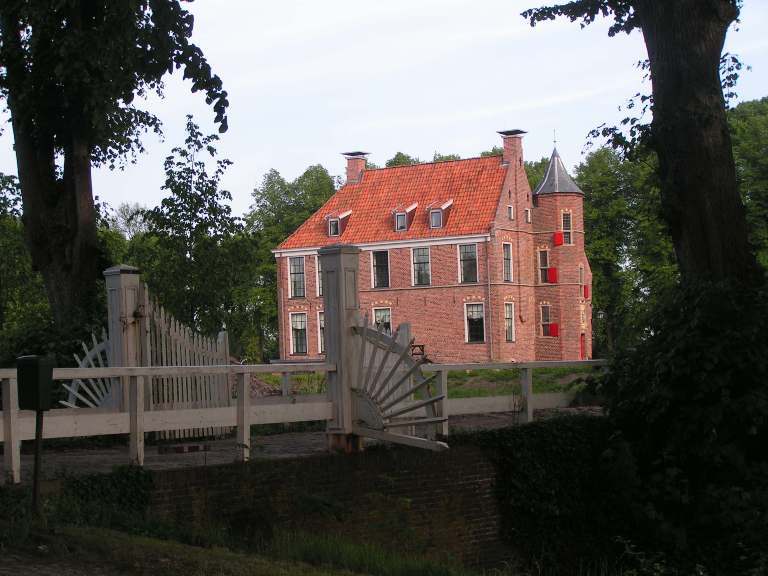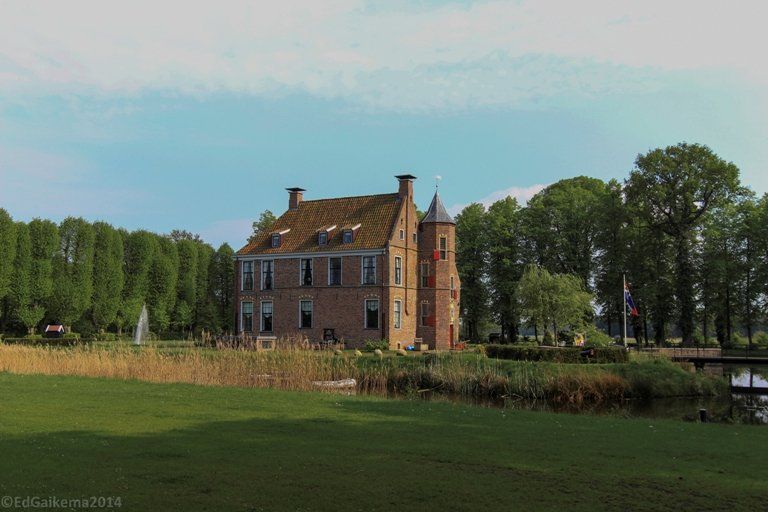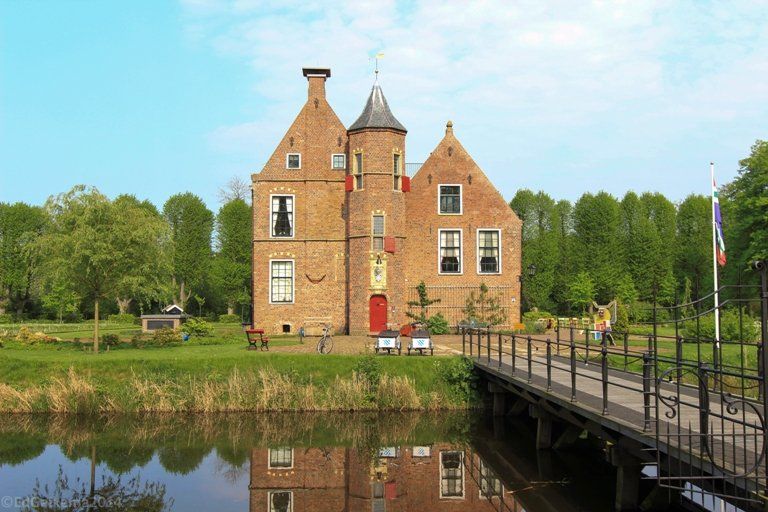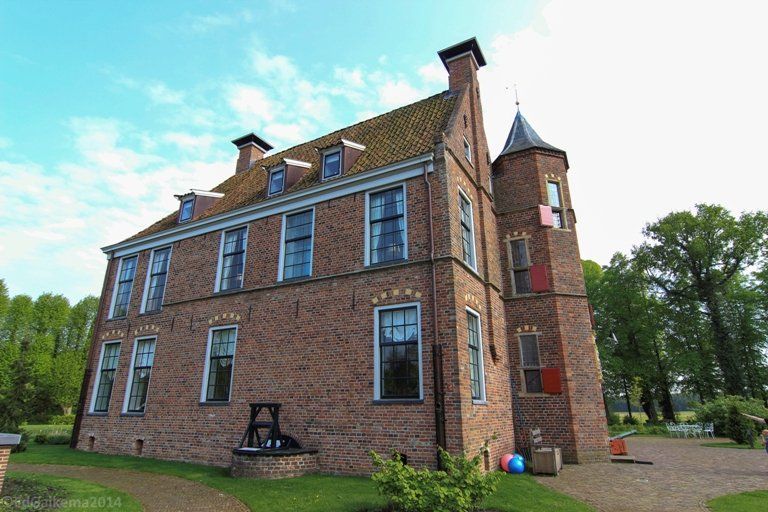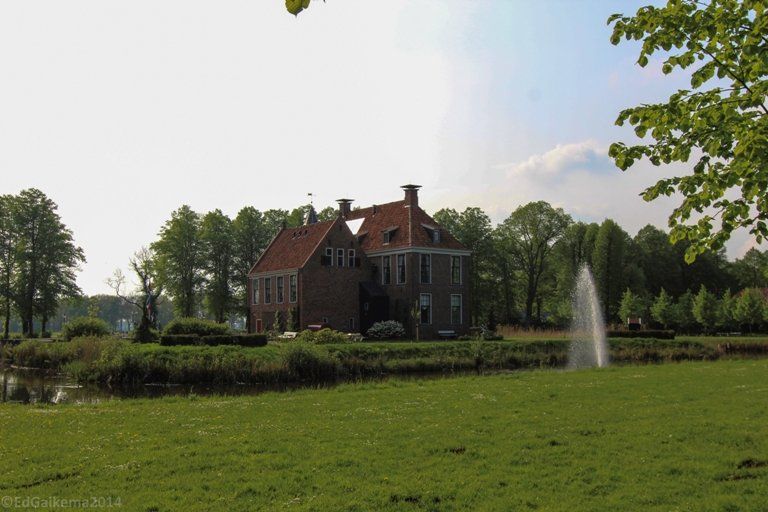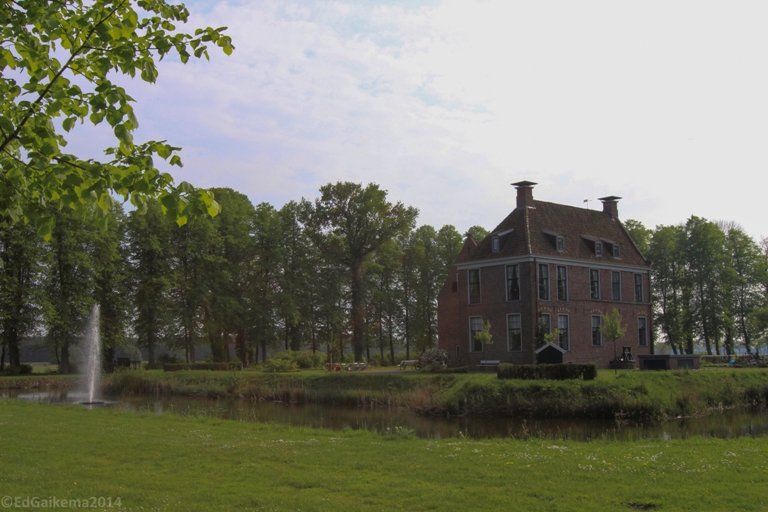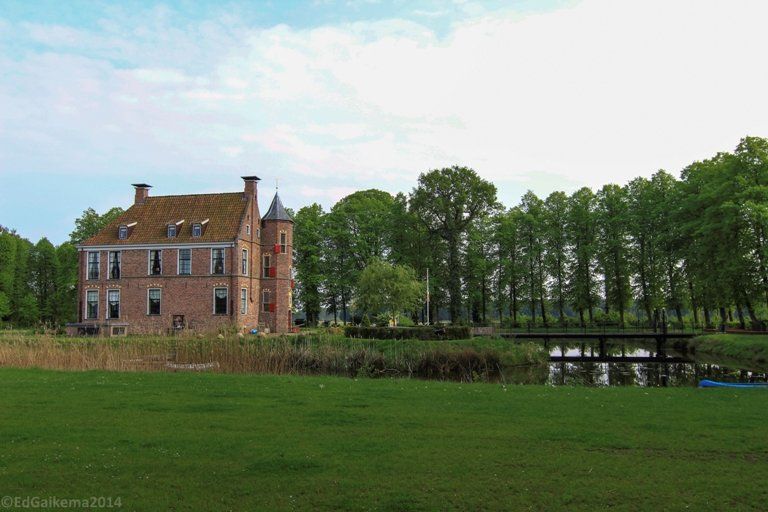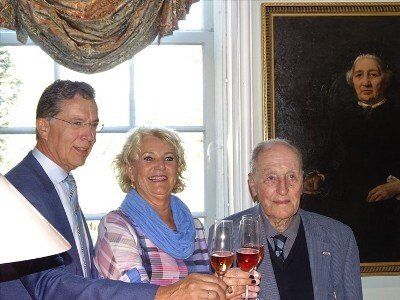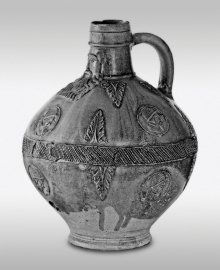The Castle of Wedde
History of the Wedde Castle
This castle adorns the covers of both family chronicles. Rightly so, because this castle plays an important role in our family history. Derck Haselhoff and after him various descendants were from 1637 to 1803 borggraaf in the service of the drost residing on the borg. They lived opposite the castle in the Borggraafhuis. They were responsible, among other things, for law enforcement in Westerwolde and for the prisoners who were locked up in the gatehouse of the castle. Court hearings for the drost were held in the Borggraafhuis, which also served as an inn. The Borggraaf house no longer exists. Today the town hall of Westerwolde stands on that spot.
The castle's history begins around 1360, when the Addinga chieftain family, driven from the Reiderland flooded by the Dollard, built a stone house. In Wedde, very strategically at the place where the trade route between the Hanseatic city of Groningen and Westfalen crosses the Westerwoldse A. Much against the will of the Westerwolders, who had agreed with their lord, the bishop of Münster, that no fortifications could be built in this area. The feudal Addinga's and the Westerwolders then live for more than a century in constant quarrel with each other: murders are committed on both sides.
In private hands
The French period (1795-1813) means the end of the seigniory of Westerwolde. The last drost left the castle and the last bailiff, Elzo Hazelhoff Jr., also lost his position in 1803. Westerwolde becomes part of the province of Groningen.
The city of Groningen then prepares to demolish the castle, but the local notary AH Koning saves the dilapidated castle from destruction by buying it and turning it into a residence. The Koning family remains the owner of the castle until 1955. In that year, the Westerwolde Water Board becomes the new owner and a thorough renovation takes place. After the East Groningen Regional Council was housed in the castle from 1977 to 1990, the property was sold to the municipality (then) Bellingwolde. Since 2011, the castle has been given a new owner and destination, thanks to the initiative of Frank Ferrari, his wife and Leo Janson. After the Burcht Wedde Foundation, set up by them, had the castle and its immediate surroundings beautifully restored, the building now houses a children's hotel, heritage accommodation and a restaurant. Some rooms have also been furnished in such a way that they give visitors an idea of the history of the castle and the surrounding area. One of those rooms has been given the name Haselhoff Sociëteit.
Above you see a photo impression of the Burcht. By clicking left or right on the photo you can navigate forward or back a photo. Photos have been published with permission from Ed Gaikema of tourismgroningen.nl.
Conquests and affiliation with Groningen
In 1478 the stone house was destroyed by troops of power-hungry Groningen, but Haye Addinga rebuilt and fortified the house in 1486 with the permission of the bishop. However, in 1530 the Addinga family lost the castle permanently, when Berend van Hackfort, an army commander under Duke Karel van Gelre, conquered the castle. He is appointed by the duke as drost of Westerwolde. Berend van Hackfort turns the stone house into a real fortress with ring walls, bastions, moats and a gatehouse with cells for the prisoners. He even has the church of Vlagtwedde demolished to get building materials.
In 1536, Westerwolde and the castle changed hands again when Georg Schenk van Toutenburg, stadtholder under Charles V, conquered the castle and took Westerwolde on loan. His coat of arms, built into the tower, is a reminder of this period. In 1561, the stadtholder of the northern provinces, the Count of Aremberg, Lord of Westerwolde, became the owner of the castle. A few years later, in 1568, at the start of the Eighty Years' War, the castle was conquered by Adolf and Louis of Nassau. In the battle of Heiligerlee, a few weeks later, both Adolf and the Count of Aremberg were killed. In 1593, Westerwolde was definitively conquered from the Spaniards by troops of the Frisian stadtholder Willem Lodewijk. The castle was heavily damaged during combat. Although the van Aremberg family remains the owner of Westerwolde and of the castle, Willem Lodewijk appoints his own drost and troops of the Republic are stationed at the castle. Westerwolde became part of the Republic of the Seven United Netherlands from that moment on and the castle in Wedde became the administrative center. The van Aremberg family sold the lordship of Westerwolde and the castle in 1617 to the merchant Willem van Hove from Alkmaar. He soon regretted this and sold his property two years later to the city of Groningen, the new lord of Westerwolde. The first 'Groninger' drost Johan Coenders appoints Derck Haselhoff as his guarantor in 1637. In the period 1666-1673 the troops of 'Bommen Berend', the bishop of Münster, conquered and occupied the castle twice. Again the castle is badly damaged and the village of Wedde is burned to the ground. In the years that followed, the castle lost its military significance and the walls and towers were demolished and the moats filled in.
The Haselhoff Society
On September 29, 2018, Humphrey Hazelhoff Roelfzema (1928) presented a special painting by Guillemina Hazelhoff Roelfzema-Verster (1816-1887) during a festive unveiling in the Haselhoff Society in the Burcht in Wedde.
Guillemina Hazelhoff Roelfzema-Verster was the wife of Dr. Karel Hazelhoff Roelfzema (1808-1869) rector of the Latin school in Zevenaar. The portrait was painted in 1887 by the renowned portraitist Henderik Johannes Haverman (1857-1928). . A family that started with Derck Haselhoff, who was appointed bailiff in 1637. There is also another (coincidental) connection between Guillemina and the Castle. Her youngest son, the art lover (and painter) Arnold Hazelhoff Roelfzema, was one of the founders of the Haagsche Kunstkring in 1891. Edzard and Arnold Koning were also members from the beginning. And these painters were both born on the Borg in Wedde at the time.
With the unveiling – in the presence of part of the Board of the De Burcht Wedde Foundation (the Kinderhotel) and the Haselhoff family foundation – of the special portrait of the founder of the Hazelhoff Roelfzema family, history, art and care for children come together symbolically.
Opening Haselhoff Society
With the new purpose of the castle, the Haselhoff Family Foundation has been given the opportunity by the Burcht Wedde Foundation to furnish one of the rooms as a memento of the period when family members were attached to the castle as guarantors. This idea could be realized partly thanks to financial contributions from donors and other family members.
This room still has an original three-part cupboard wall from the 18th century. A display case has been installed in this in which objects are exhibited that were found during excavations around the castle. For example, a bearded man's jug (ca. 1600) that was found on the site of the former Borggraaf house. The ten chairs around the large table bear the Haselhoff coat of arms. The names of the drosten and borggraves from the period when the city of Groningen was lord of Westerwolde and the borggraaf function was exercised by the Haselhoff family are mentioned on two painted wooden wall plates. The most interesting part of the Haselhoff Society is formed by three glass wall plates, each one meter by one meter. The artists Rudmer Nijman and Elske Hiddema depict the history of Westerwolde, the castle and the Haselhoff borggrave family on these plates under the title Wedderworthyheden. It concerns the period that begins in 1568 with the Battle of Heiligerlee and ends in 1795 with the invasion of French troops and the proclamation of the Batavian Republic.
The Haselhoff Society is available to hotel guests of the castle. Meetings and dinner can also be arranged. The Society is freely accessible to other visitors to the castle.
Baardmankruik
Around 1960, a crane operator excavated a bearded man's jug while working on the construction of the new office for the Dollardzijlvest water board in Wedde. Today this building is used as the town hall of Westerwolde. The Borggraaf house used to be on or near this spot, opposite the borg. From 1637 until the first half of the 19th century, several generations of our family lived and worked in this house as bailiff. It is therefore possible that this jug was once in the possession of the Haselhoff family.
Bartman pitchers were made in the area around the city of Cologne from the 15th to the 18th century. Art historians disagree on what the bearded man on the neck of the pitchers symbolizes. According to tradition, the bearded man's head should represent God. According to another explanation, Cologne potters, who were expelled from the city of Cologne in the 16th century, put the faces of the Cologne city administrators on the necks of the beardman jars out of anger. The potters are said to have been chased away because of the poison gas released during their firing process. This sparked a riot and many potters settled in nearby Frechen. In the sixteenth and seventeenth centuries, bearded man's jars were very common in Europe as storage jars, such as for storing brandy. They also went on board VOC ships to Japan. We cannot say with certainty how old our bearded man is. Some experts consulted for the time being consider the period between 1550 and 1650. The Borggraafhuis in Wedde was not only a courthouse - the place where the drost held his court hearings - but also an inn and residence of the Borggraaf and his family. The yard around the Borggraafhuis extended to the bank of the Westerwoldse A, the waterway connection to the Dollard and the North Sea. The excavator operator who kept the bearded man's jar at home for forty years said he excavated the jar at the suspected site of a former turning basin. A place where the ships could turn. This could explain that the bearded man's pitcher has remained virtually undamaged. He may have fallen overboard or thrown into the water. It is also easy to imagine that the jug was used in the Borggraaf house. The drost, or the guests staying in the inn, will have taken a sip from time to time. Given the estimated age of the jug, it is not inconceivable that a bailiff Haselhoff filled the necessary glasses or cups with the contents of this jug.


